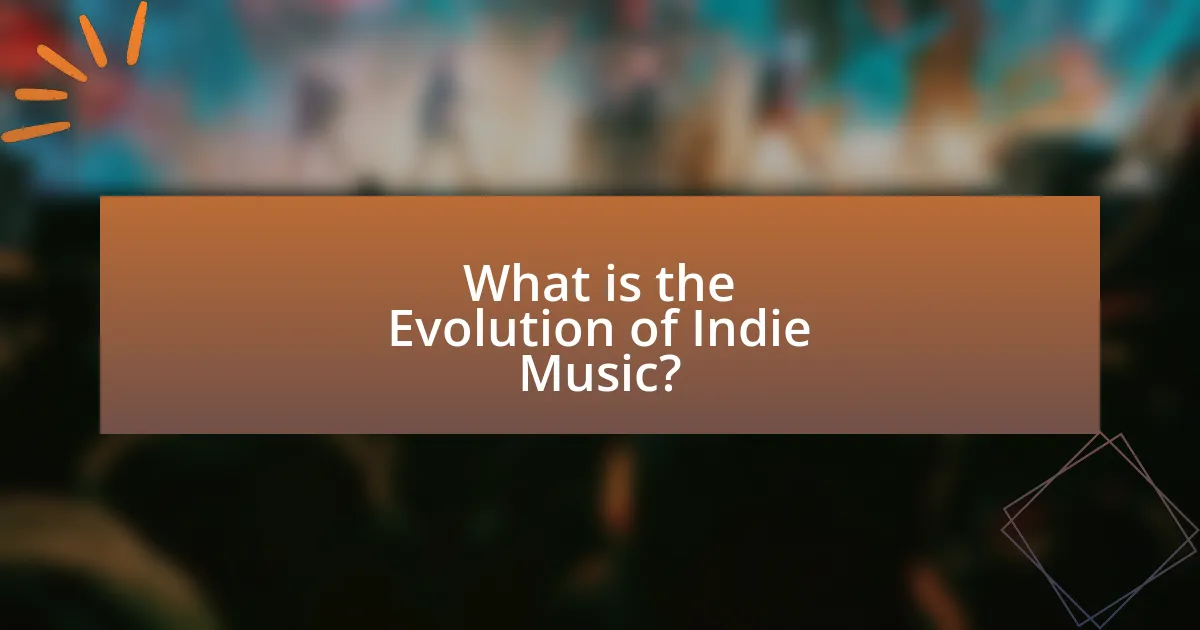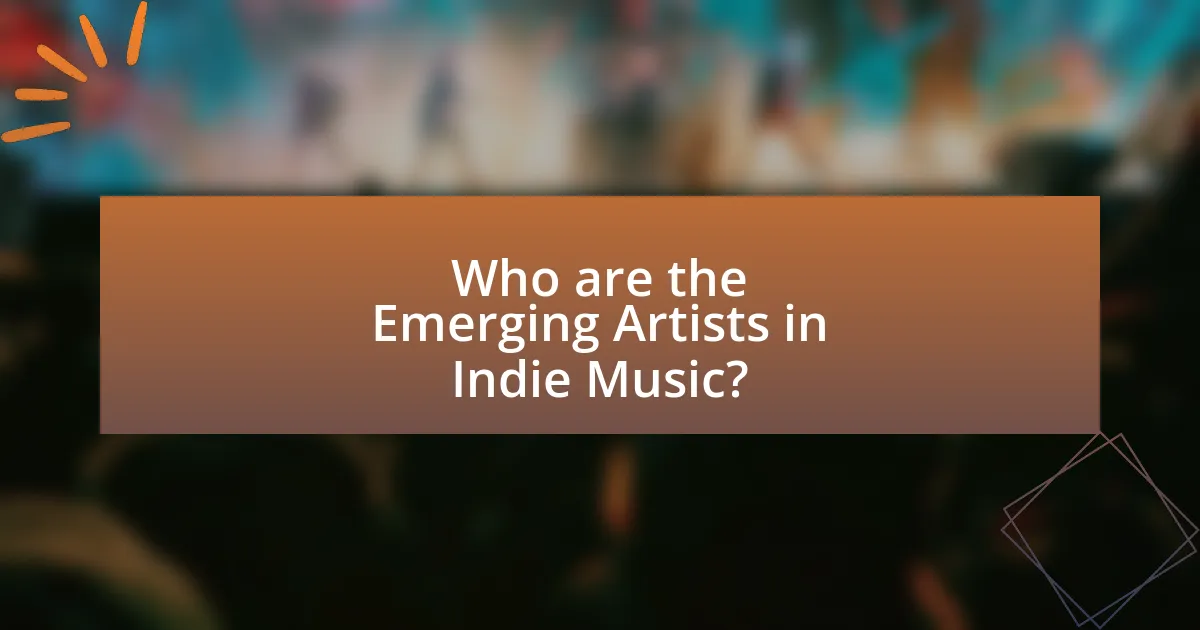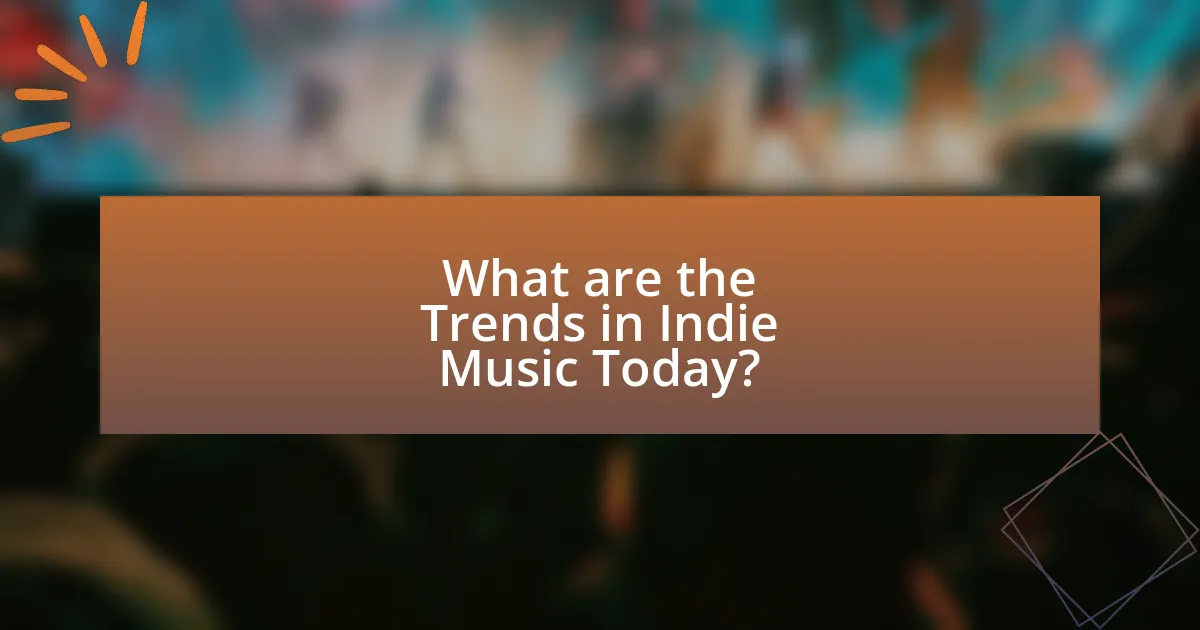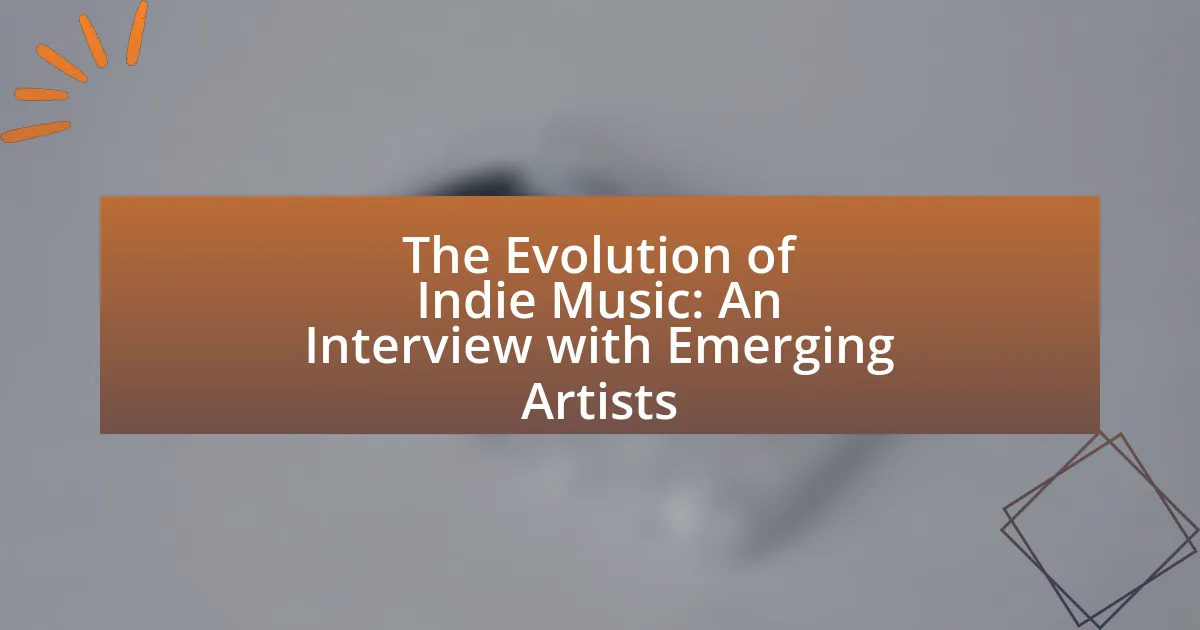The article examines the evolution of indie music, tracing its origins from the 1980s as a response to mainstream commercialization to its current status as a significant force in the music industry. It highlights key developments, including the rise of independent record labels, the impact of digital technology, and the emergence of online platforms that have democratized music distribution. The article also explores the significance of indie music in cultural movements, the challenges faced by emerging artists, and current trends shaping the genre. Additionally, it features insights from interviews with emerging artists, providing a comprehensive overview of their experiences and the strategies they employ to succeed in a competitive landscape.

What is the Evolution of Indie Music?
The evolution of indie music began in the 1980s as a response to the mainstream music industry’s commercialization, with artists seeking creative freedom and alternative distribution methods. Initially characterized by DIY ethics, indie music gained traction through independent record labels and underground scenes, exemplified by bands like R.E.M. and The Smiths. The 1990s saw a significant rise in popularity, with the emergence of genres like indie rock and pop, driven by the success of acts such as Pavement and Belle and Sebastian. The advent of the internet in the 2000s further transformed indie music, allowing artists to reach global audiences without major label support, leading to the rise of platforms like Bandcamp and SoundCloud. By the 2010s, indie music had diversified, incorporating various genres and styles, with artists like Bon Iver and Tame Impala achieving mainstream success while maintaining their independent roots. This trajectory illustrates how indie music has continually adapted to cultural shifts and technological advancements, solidifying its place in the broader music landscape.
How has indie music changed over the decades?
Indie music has evolved significantly over the decades, transitioning from a niche genre in the 1980s to a mainstream force by the 2010s. In the 1980s, indie music was characterized by its DIY ethos, with artists often self-releasing music and operating outside major label systems. By the 1990s, the genre began to gain traction, with bands like Nirvana and Radiohead bringing indie sounds to wider audiences, leading to the establishment of independent labels that helped promote diverse artists.
In the 2000s, the rise of digital technology and platforms like MySpace and Bandcamp allowed indie musicians to reach global audiences without traditional gatekeepers, further democratizing music distribution. By the 2010s, indie music had become a significant part of popular culture, with artists like Bon Iver and Tame Impala achieving commercial success while maintaining their independent roots. This shift reflects broader changes in music consumption, with streaming services enabling listeners to discover a vast array of indie artists.
Overall, indie music has transformed from an underground movement into a vital component of the global music landscape, marked by increased accessibility and diversity in sound and style.
What key events have influenced the evolution of indie music?
Key events that have influenced the evolution of indie music include the rise of independent record labels in the 1980s, the advent of digital technology in the 1990s, and the emergence of online music distribution in the 2000s. The establishment of labels like Sub Pop and 4AD in the 1980s allowed artists to produce and distribute music outside of major label systems, fostering a DIY ethos. The introduction of digital recording and distribution technologies in the 1990s enabled artists to create and share music more easily, leading to a surge in indie music production. Additionally, platforms like Bandcamp and SoundCloud in the 2000s revolutionized how indie artists reached audiences, allowing for greater accessibility and diversity in the music landscape. These events collectively shaped the indie music scene, promoting artistic freedom and innovation.
How have technological advancements impacted indie music?
Technological advancements have significantly transformed indie music by enabling artists to produce, distribute, and promote their work independently. The rise of digital audio workstations (DAWs) and affordable recording equipment has democratized music production, allowing indie musicians to create high-quality recordings without the need for expensive studio time. Additionally, platforms like Bandcamp, SoundCloud, and Spotify have revolutionized music distribution, providing artists with direct access to global audiences and eliminating traditional gatekeepers like record labels. According to a 2021 report by the International Federation of the Phonographic Industry, independent labels accounted for 40% of global recorded music revenue, highlighting the impact of technology on the indie music landscape.
Why is indie music significant in today’s music landscape?
Indie music is significant in today’s music landscape because it fosters artistic freedom and diversity, allowing artists to explore unique sounds and themes without the constraints of major label expectations. This genre has gained prominence as streaming platforms have democratized music distribution, enabling independent artists to reach global audiences. According to a 2021 report by the International Federation of the Phonographic Industry, independent labels accounted for 40% of global recorded music revenue, highlighting their growing influence. Additionally, indie music often reflects social and cultural movements, resonating with listeners seeking authenticity and connection in their musical experiences.
What role does indie music play in cultural movements?
Indie music plays a significant role in cultural movements by serving as a platform for artistic expression and social commentary. This genre often reflects and challenges societal norms, allowing artists to address issues such as identity, politics, and social justice. For instance, the rise of indie music in the 1990s coincided with various cultural shifts, including the feminist movement and LGBTQ+ rights, where artists like Ani DiFranco and The Magnetic Fields used their music to advocate for change. Additionally, indie music fosters community and grassroots activism, as seen in events like local music festivals that promote awareness and solidarity around social causes.
How does indie music differ from mainstream genres?
Indie music differs from mainstream genres primarily in its production and distribution methods, as well as its artistic approach. Indie music is typically produced independently from major record labels, allowing artists greater creative freedom and control over their work. This independence often results in a more diverse range of sounds and styles, as indie artists are less constrained by commercial pressures that mainstream genres face. For instance, according to a 2020 report by the International Federation of the Phonographic Industry, indie labels accounted for 39% of global recorded music revenue, highlighting the significant impact and reach of independent music despite its non-mainstream status.

Who are the Emerging Artists in Indie Music?
Emerging artists in indie music include musicians such as Phoebe Bridgers, Snail Mail, and Soccer Mommy. These artists have gained recognition for their unique sound and storytelling abilities, contributing to the evolution of the genre. For instance, Phoebe Bridgers’ album “Punisher” received critical acclaim and was nominated for multiple Grammy Awards, showcasing her impact on the indie music scene. Similarly, Snail Mail’s debut album “Lush” has been praised for its introspective lyrics and innovative melodies, solidifying her place among rising talents. Soccer Mommy’s work, particularly her album “Clean,” has also garnered attention for its relatable themes and catchy hooks, further illustrating the diversity and creativity within the current indie music landscape.
What defines an emerging artist in the indie music scene?
An emerging artist in the indie music scene is defined as a musician or band that is gaining recognition and building a following, typically characterized by their independent production and distribution of music. These artists often have limited commercial success but demonstrate potential for growth through unique sound, innovative approaches, and engagement with niche audiences. According to a 2021 report by the Music Industry Research Association, emerging artists often leverage social media platforms and streaming services to reach listeners, which has become a crucial factor in their development and visibility in the competitive music landscape.
How do emerging artists gain recognition in the industry?
Emerging artists gain recognition in the industry primarily through social media platforms, live performances, and collaborations. Social media allows artists to showcase their work, engage with fans, and build a following; for instance, platforms like Instagram and TikTok have been instrumental in launching careers for many musicians. Live performances at local venues and festivals provide exposure and networking opportunities, enabling artists to connect with industry professionals and audiences directly. Collaborations with established artists can also enhance visibility, as seen with numerous indie artists who have gained traction by partnering with more recognized musicians. These methods collectively contribute to an artist’s growth and visibility in a competitive landscape.
What challenges do emerging artists face today?
Emerging artists today face significant challenges, including limited access to funding, competition in a saturated market, and difficulties in gaining visibility. Limited funding restricts their ability to produce high-quality music and promote their work effectively. According to a 2021 survey by the Music Industry Research Association, 70% of independent artists reported financial constraints as a major barrier to their success. Additionally, the oversaturation of the music market makes it challenging for new artists to stand out, with over 60,000 tracks uploaded to streaming platforms daily, as reported by Spotify. Finally, gaining visibility is increasingly difficult due to algorithm-driven platforms that favor established artists, leaving new talent struggling to reach audiences.
Why are interviews with emerging artists important?
Interviews with emerging artists are important because they provide insight into new creative perspectives and trends within the music industry. These discussions highlight the unique experiences and challenges faced by artists who are just beginning their careers, allowing audiences to connect with their stories and understand the evolving landscape of indie music. Furthermore, interviews can serve as a platform for these artists to share their influences, artistic processes, and aspirations, fostering a deeper appreciation for their work. This engagement not only supports the artists’ visibility but also enriches the cultural dialogue surrounding contemporary music.
What insights can we gain from their experiences?
Emerging artists in indie music provide insights into the evolving landscape of the genre, highlighting the importance of authenticity and community engagement. Their experiences reveal that success often stems from building genuine connections with audiences and leveraging social media platforms for promotion. For instance, many artists report that grassroots marketing strategies, such as local performances and collaborations, significantly enhance their visibility and fanbase. Additionally, their narratives emphasize the necessity of adaptability in a rapidly changing industry, where trends can shift overnight. This adaptability is supported by data showing that independent artists who embrace diverse musical influences and innovative distribution methods tend to achieve greater reach and resonance with listeners.
How do their stories reflect the evolution of indie music?
The stories of emerging artists reflect the evolution of indie music by showcasing the shift from traditional label-driven models to a more democratized, self-sufficient approach. These artists often leverage digital platforms for distribution and promotion, illustrating the impact of technology on music accessibility. For instance, the rise of social media and streaming services has enabled independent musicians to reach global audiences without the need for major label backing, as evidenced by artists like Chance the Rapper, who gained fame through platforms like SoundCloud. This transition highlights a broader trend in indie music where creativity and authenticity take precedence over commercial viability, marking a significant evolution in the genre’s landscape.

What are the Trends in Indie Music Today?
Current trends in indie music today include a rise in genre-blending, increased use of digital platforms for distribution, and a focus on authenticity and personal storytelling. Artists are increasingly mixing elements from various genres, such as pop, rock, electronic, and folk, to create unique sounds that resonate with diverse audiences. The digital landscape has empowered indie musicians to distribute their music directly to fans through platforms like Bandcamp and SoundCloud, bypassing traditional record labels. Additionally, there is a growing emphasis on lyrical content that reflects personal experiences and social issues, which resonates with listeners seeking genuine connections. According to a 2023 report by the Music Industry Association, 70% of indie artists prioritize storytelling in their music, highlighting this trend’s significance in the current indie music scene.
How are current trends shaping the future of indie music?
Current trends are shaping the future of indie music by fostering greater accessibility and diversity in music production and distribution. The rise of digital platforms like Bandcamp and SoundCloud allows independent artists to reach global audiences without traditional label support, leading to a more varied musical landscape. Additionally, the increasing use of social media for promotion enables artists to connect directly with fans, facilitating grassroots movements and niche genres. According to a 2022 report by the International Federation of the Phonographic Industry, independent music accounted for 40% of global music revenue, highlighting the significant impact of these trends on the industry’s future.
What genres are gaining popularity within the indie scene?
Genres gaining popularity within the indie scene include indie pop, lo-fi, and bedroom pop. Indie pop has seen a resurgence due to its catchy melodies and relatable lyrics, appealing to a younger audience. Lo-fi music, characterized by its raw sound and DIY ethos, has gained traction through platforms like Bandcamp and SoundCloud, where artists can easily share their work. Bedroom pop, often created by artists recording at home, has become prominent as it reflects personal experiences and intimacy, resonating with listeners seeking authenticity. The rise of these genres is supported by streaming data, which shows increased listener engagement and playlist placements on platforms like Spotify.
How are social media and streaming platforms influencing indie music trends?
Social media and streaming platforms are significantly influencing indie music trends by providing artists with direct access to audiences and enabling viral marketing. These platforms allow indie musicians to share their work widely without the need for traditional record labels, leading to increased visibility and engagement. For instance, according to a 2021 report by the International Federation of the Phonographic Industry, 70% of music listeners discover new artists through streaming services and social media, highlighting the critical role these platforms play in shaping music consumption habits. Additionally, platforms like TikTok have been instrumental in propelling indie tracks to mainstream success, as songs can go viral and reach millions of listeners rapidly, demonstrating the power of social media in transforming indie music trends.
What practical tips can emerging artists use to succeed in indie music?
Emerging artists can succeed in indie music by focusing on building a strong online presence and engaging with their audience. Establishing a professional website and utilizing social media platforms effectively allows artists to showcase their music, share updates, and connect with fans. According to a 2021 survey by the Music Industry Research Association, 70% of independent artists reported that social media was crucial for their career growth. Additionally, collaborating with other musicians and participating in local music scenes can enhance visibility and create networking opportunities. Engaging in live performances, even in small venues, helps artists gain experience and build a loyal fan base.
How can artists effectively promote their music in a crowded market?
Artists can effectively promote their music in a crowded market by leveraging social media platforms to engage directly with their audience. Research indicates that 90% of musicians use social media for promotion, with platforms like Instagram and TikTok being particularly effective for reaching younger demographics. By creating authentic content, collaborating with influencers, and utilizing targeted ads, artists can enhance their visibility. Additionally, participating in live performances and virtual events allows artists to connect with fans in real-time, fostering a loyal community. Data shows that artists who engage with their audience through live streams see a 30% increase in fan interaction.
What strategies should emerging artists adopt for building a fanbase?
Emerging artists should adopt a multi-faceted approach to building a fanbase, focusing on social media engagement, live performances, and collaborations. Social media platforms like Instagram and TikTok allow artists to connect directly with potential fans, share their music, and create engaging content that resonates with audiences. According to a 2021 report by the International Federation of the Phonographic Industry, 70% of music consumers discover new artists through social media.
Live performances, whether virtual or in-person, help artists showcase their talent and create memorable experiences for attendees, fostering a personal connection. A study by Eventbrite found that 78% of millennials prefer to spend money on experiences rather than material goods, highlighting the importance of live events in fan engagement.
Collaborations with other artists can also expand reach and introduce emerging artists to new audiences. Research from Spotify indicates that collaborative tracks often perform better on streaming platforms, increasing visibility and fan engagement. By implementing these strategies, emerging artists can effectively build and grow their fanbase.
